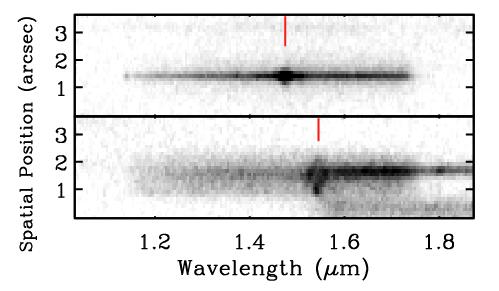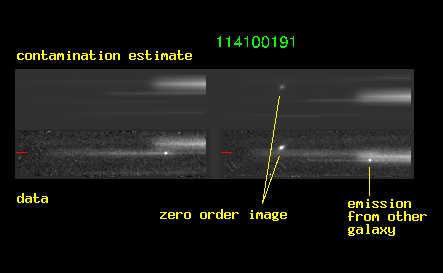

AGHAST is a Hubble Space Telescope cycle 17 program. We use the WFC3-IR camera and G141 grism to take slitless spectroscopy of an area covering ~3/4 of the GOODS-N deep field. The spectra cover 1.1 - 1.65 microns at low resolution, R ~50. There are 28 pointings each about 2.1 x 2.0 arcmin, each with 2 orbits split among 4 dither positions. The typical exposure time per pointing is total 800 sec in F140W and ~5200 sec in G141. The area, efficiency, and clean data of the WFC3-IR camera make it a much faster survey instrument for imaging and spectroscopy than previously available in the near-IR with HST, enabling a true redshift survey over a significant area.
For a non-technical introduction to HST grism slitless spectroscopy and what we can do with it, especially in the infrared, have a look at Ben Weiner's introduction to HST grism spectroscopy on the blog of the CANDELS collaboration.
The main goal of AGHAST is to measure H-alpha emission for galaxies at redshifts 0.7 to 1.5. AGHAST can also detect other emission lines, especially [O III] in galaxies at z~2, and measures spatial information on the emission size of galaxies at redshift z~1-2, since slitless spectra provide emission line images of galaxies at the high resolution of HST.
It has been difficult to measure emission lines in the infrared for large samples of galaxies. H-alpha is especially valuable since it is a well calibrated indicator of star formation in local galaxies, and together with other lines can be used to measure extinction and metallicity. The difficulty of detecting H-alpha and calibrating ground based infrared spectra has been a hindrance to studies of sar formation rates, extinction, and metallicity at high redshift. The stable flux calibration provided by HST is a significant advance over what can be done from the ground.
AGHAST also measures spectra and redshifts for galaxies too faint or reddened to have been selected for ground-based spectroscopic surveys in the optical. This yields a significant number of new redshifts (more than we expected from the original proposal) at fairly faint infrared magnitudes, H~23 and even down to H~25.
AGHAST's PI is Benjamin Weiner (U. of Arizona), and the proposal team includes Michael Cooper (UC Irvine), Susan Kassin (NASA/GSFC), Janice Lee (STScI), Kai Noeske (STScI), Casey Papovich (Texas A&M), and Christopher Willmer (Arizona).

Above, we show an example of measuring H-alpha emission and size in WFC3-IR grism data. These are two galaxies in GOODS-N that are both infrared-bright, with L_IR ~ 10^12 Lsun, roughly ULIRGs. One is compact, and the other is large - its F140W image looks like a large spiral galaxy - and has emission in several bright knots in the galaxy disk. (Figure made by Michael Cooper and BJW.)

If the previous spectra were the good, this one is the ugly. Here we show an example of the complexity of grism data. This is actually from a CANDELS WFC3-IR grism observation, where we have two pointings at different roll angles, which leads to different inter-object contamination. This is a screenshot from a GUI we use to examine the spectra for redshift quality control, with annotations added. The images on the bottom row are data and on the top row show the contamination model, not including the object under inspection; the images on the left are one roll angle and the right are the second roll angle. Dispersion is along the horizontal axis. A red tickmark shows the expected location of the object. Note that on the right in the second roll angle, the bright emission line is vertically displaced, showing it actually belongs to a different galaxy. Fortunately an overlap this potentially misleading only happens in a relatively small fraction of spectra. The second roll angle also has zero-order images from a bright object, but these are usually easier to weed out since they are modeled in the contamination estimate.
We plan an initial data and catalog release in fall 2012. This will accompany a science paper that includes an AGHAST survey description, and will include images, catalogs from direct imaging, and a preliminary redshift catalog, subject to quality control.
AGHAST is Hubble Space Telescope program ID 11600. Detailed information for the AGHAST program and exposure catalogs is available from the HST website, and data is retrievable from the HST archive at MAST, the Mikulski Archive for Space Telescopes at STScI. The basic AGHAST data has no proprietary period and has always been available for download from MAST.
Please note that a number of early AGHAST visits were heavily affected by scattered light from the bright Earth limb and have high and non-uniform background; WFC3-IR appears to be sensitive to scattered light beyond the normal HST Earth avoidance angle. The HST telescope time review board granted us time to redo these exposures, so if you download and use the data, make sure to retrieve the new data and exclude the corresponding previous high-background exposures.
For any questions about AGHAST please contact Benjamin Weiner at bjw -at- as.arizona.edu.
Benjamin Weiner's
home page
Benjamin Weiner, bjw at as.arizona.edu